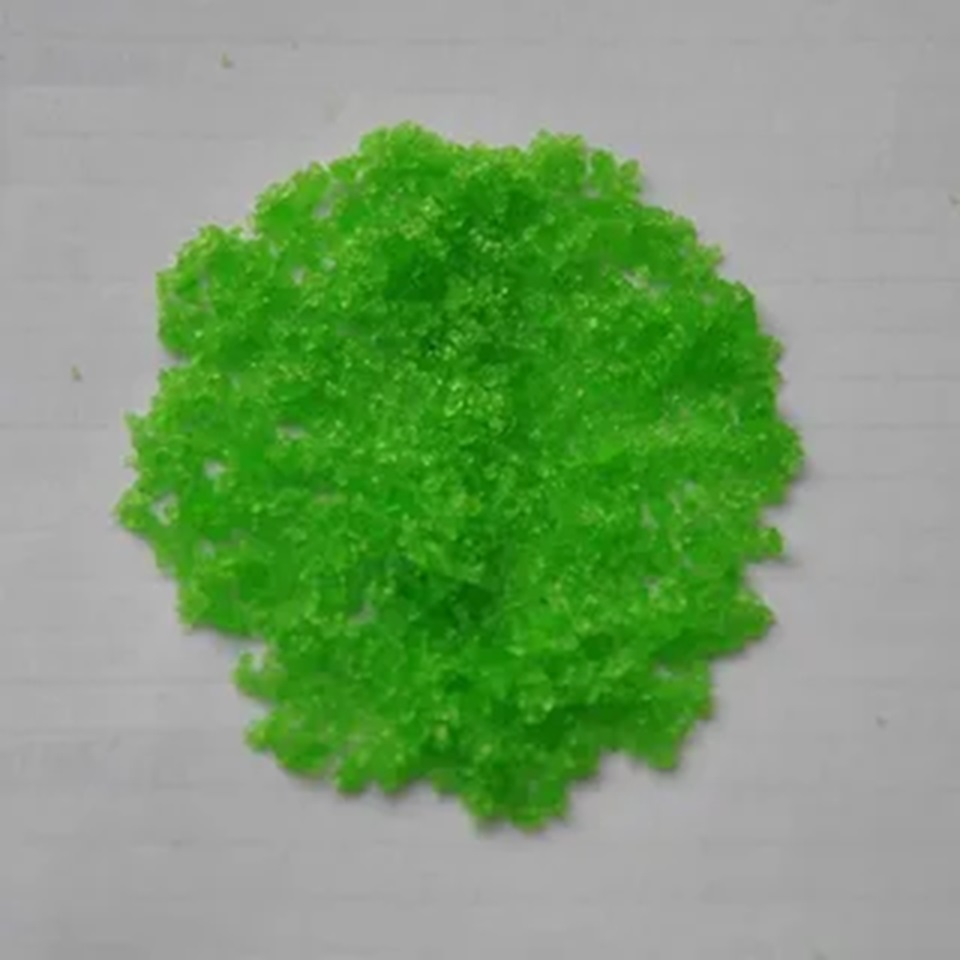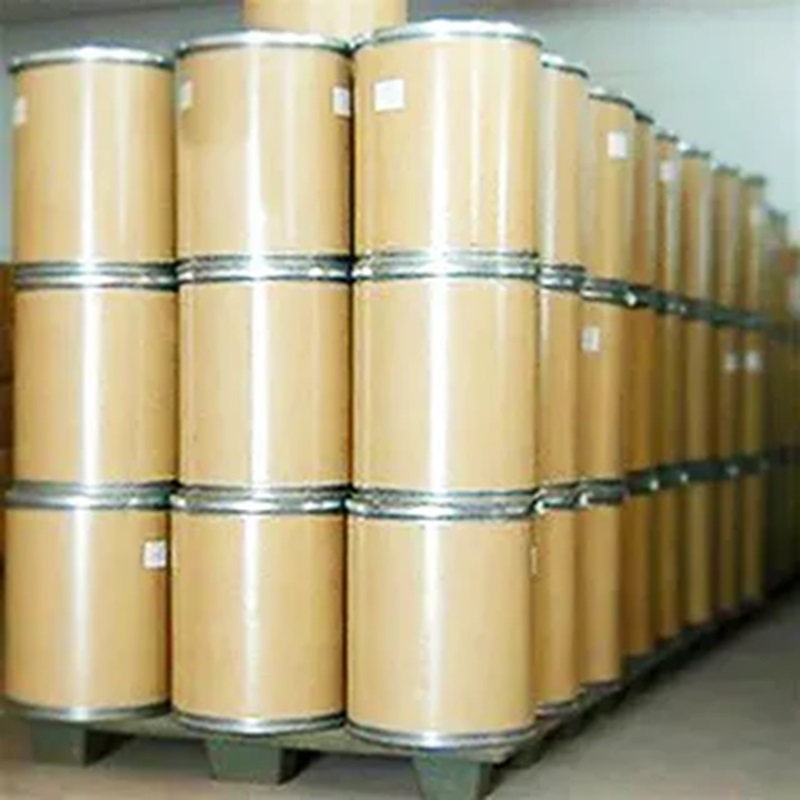We unleash your business potential by maximize the business innovation.
Send EmailNICKEL CHLORIDE, Nickel chloride, NiCl2, 7718-54-9, 37211-05-5
Nickel chloride
CAS: 7718-54-9;37211-05-5
Molecular Formula: Cl2Ni
Names and Identifiers
| Name | Nickel chloride |
| Synonyms | NiCl2 Nickel chloride NICKEL CHLORIDE NICKEL(+2)CHLORIDE Nickel(II) chloride nickel(2+) dichloride nickeldichloride(nickel(ii)chloride) nickel atomic spectroscopy standard concentrate 1.00 g ni |
| CAS | 7718-54-9 37211-05-5 |
| EINECS | 231-743-0 |
| InChI | InChI=1/2ClH.Ni/h2*1H;/q;;+2/p-2 |
| InChIKey | QMMRZOWCJAIUJA-UHFFFAOYSA-L |
Physico-chemical Properties
| Molecular Formula | Cl2Ni |
| Molar Mass | 129.6 |
| Density | 3.55g/mLat 25°C(lit.) |
| Melting Point | 1001 °C |
| Boling Point | 987°C |
| Water Solubility | slightly soluble |
| Solubility | H2O: soluble |
| Vapor Presure | 1.33 hPa (671 °C) |
| Appearance | powder |
| Specific Gravity | 3.55 |
| Color | Yellow to orange |
| Exposure Limit | ACGIH: TWA 0.1 mg/m3NIOSH: IDLH 10 mg/m3; TWA 0.015 mg/m3 |
| Merck | 14,6505 |
| PH | 4 (500g/l, H2O, 20℃) |
| Storage Condition | Store below +30°C. |
| Stability | Stable. Incompatible with peroxides. |
| Sensitive | Hygroscopic |
| Physical and Chemical Properties | Density 3.55 melting point 1001°C water-soluble easily soluble |
| Use | Used for nickel plating, making hidden ink and ammonia absorbent, etc |
Risk and Safety
| Risk Codes | R45 - May cause cancer R25 - Toxic if swallowed R36/38 - Irritating to eyes and skin. R43 - May cause sensitization by skin contact R50 - Very Toxic to aquatic organisms R50/53 - Very toxic to aquatic organisms, may cause long-term adverse effects in the aquatic environment. R22 - Harmful if swallowed R52/53 - Harmful to aquatic organisms, may cause long-term adverse effects in the aquatic environment. R68 - Possible risk of irreversible effects R51/53 - Toxic to aquatic organisms, may cause long-term adverse effects in the aquatic environment. R48/23 - R42/43 - May cause sensitization by inhalation and skin contact. R20/22 - Harmful by inhalation and if swallowed. R61 - May cause harm to the unborn child R49 - May cause cancer by inhalation R38 - Irritating to the skin R23/25 - Toxic by inhalation and if swallowed. |
| Safety Description | S53 - Avoid exposure - obtain special instructions before use. S26 - In case of contact with eyes, rinse immediately with plenty of water and seek medical advice. S36/37 - Wear suitable protective clothing and gloves. S45 - In case of accident or if you feel unwell, seek medical advice immediately (show the label whenever possible.) S61 - Avoid release to the environment. Refer to special instructions / safety data sheets. S37 - Wear suitable gloves. S29 - Do not empty into drains. S24 - Avoid contact with skin. S23 - Do not breathe vapour. S60 - This material and its container must be disposed of as hazardous waste. |
| UN IDs | UN 3288 6.1/PG 3 |
| WGK Germany | 3 |
| RTECS | QR6475000 |
| FLUKA BRAND F CODES | 3 |
| TSCA | Yes |
| HS Code | 28273500 |
| Hazard Class | 6.1(b) |
| Packing Group | III |
| Toxicity | LD50 in mice, rats (mg/kg): 48, 11 i.p. (IARC) |
Upstream Downstream Industry
| Raw Materials | Sodium carbonate Sulfuric acid Nickelous sulfate Nickel nickel carbonate Nitric acid Hydrochloric acid |
Nature
Green or grass-green monoclinic prism-like crystals. Relative density 11 921. Melting point 80 °c. Soluble in water, ethanol, its aqueous solution is slightly acidic. It is easily weathered in dry air and deliquescent in moist air. Upon heating above 140 °c, the water of crystallization is completely lost and the powder is yellow-brown in color.
Preparation Method
metal nickel Method: Add the gold scrap nickel into the acidolysis device containing a suitable amount of water or mother liquor, then add nitric acid and sulfuric acid to react to generate nickel sulfate solution, and send it to the neutralization reactor, adding soda ash solution for neutralization reaction to generate nickel carbonate, after filtering and separating sodium sulfate, wash with water
Nickel carbonate is added to the reactor and acidified with hydrochloric acid to form nickel chloride, hydrogen peroxide and barium salt are added to purify the solution, iron and sulfate are removed by filtration, and then concentrated by evaporation, cooled crystallization and centrifugal separation, finished nickel chloride hexahydrate was obtained. The nitrogen oxide gas released from the reaction can be absorbed by ammonia water to make ammonium nitrate by-product.
Use
used for nickel plating, as an anode activator in rapid nickel plating, and as an ammonia absorber in industrial or gas masks. For the manufacture of catalysts, preservatives, dry batteries. Used in the manufacture of other nickel salts. It is also used in the manufacture of cryptic inks.
Safety
plastic woven bag or carton packed with polyethylene plastic bag, with a net weight of 25kg. There shall be firm and clear marks on the outer package, including: name of manufacturer, address, product name, brand name, grade, net weight, batch number or date of production, and signs of "fear of heat" and "fear of Humidity. Should be stored in a cool, ventilated, dry warehouse. During transport to prevent rain and sun. When loading and unloading should be light to prevent packaging damage. Mixing with oxidant and active metal is strictly prohibited. Fire, can use fog water, foam, dry powder, carbon dioxide, sand, etc. Toxicity and protection: nickel chloride non-flammable, toxic. It is harmful to the environment and can cause pollution to water bodies. Contacts may develop contact dermatitis or allergic eczema. Inhalation of this product dust, bronchitis or bronchial pneumonia, allergic pneumonia, and may occur adrenal insufficiency. Nickel compounds are carcinogens. The patient should drink enough warm water to induce vomiting and seek medical advice. Operators must be specially trained and strictly follow the operating procedures. It is recommended that operators wear self-priming filter dust masks, chemical safety glasses, rubber acid and alkali resistant clothing and latex gloves. Dust should be avoided. Avoid contact with peroxides and potassium. Emergency treatment equipment for leakage shall be provided. Occupational exposure limit: China
Reference Information
| Overview | nickel chloride is green or grass-green monoclinic prism-like crystals at room temperature. In the dry air stroke, deliquescence in the humid air, in the vacuum can quickly absorb ammonia, heat lost part of the crystal water, more than 140 deg C when completely lost crystal water into yellow-brown anhydrous nickel chloride. Soluble in water, ethanol and ammonia, aqueous solution is acidic. The chemical industry is used to manufacture various nickel compounds, preservatives and catalysts for chemical reactions, and is also used to manufacture hidden inks, the electroplating industry is used for nickel plating, and is used as an analytical reagent in analytical chemistry, etc. In addition, the anhydrous substance is used as an ammonia absorbent for a gas mask. nickel reagent is toxic and carcinogenic, so it must be used with caution. |
| Chemical reaction | nickel chloride can be used as a mild Lewis acid to participate in the reaction, and can also catalyze the coupling reaction, and the metal hydride is used as a reducing reagent to participate in the selective reduction reaction. Nickel Chloride, as a mild Lewis acid, can achieve regioselective rearrangement of dienols in aqueous alcohol solutions. If the reaction is under the action of protic acid, the dehydrogenation product will be given. Under the action of other Lewis acids such as nickel acetate, palladium chloride and copper chloride, the yield is low, and only under the action of nickel chloride can a high yield be obtained. Similar to other metal halides, nickel chloride can be converted into low-cost metal reagents under the action of reducing reagents such as lithium aluminum hydride, thereby realizing selective reduction reactions for various functional groups, such as the reduction of olefins to alkanes, the alkyne is reduced to a cis-olefin, and a cleavage reaction of a N-O bond is achieved. Nickel chloride as a Lewis acid can also catalyze the reaction of cyanotrimethylsilanes with α,β-unsaturated acetals to give the corresponding α-cyano derivatives. The combination of nickel chloride and chromium dichloride is also effective in the reaction of aldehydes with vinyl iodide to give Allyl Alcohol compounds. This type of reaction allows the presence of various functional groups such as esters, amides, cyanides, ketones, acetals, ethers, silyl ethers, alcohols, alkenes and alkynes, thus enabling the efficient preparation of various types of allyl alcohol compounds. In the presence of phosphine ligands, nickel chloride and chromium dichloride catalytic systems are also capable of achieving enyne coupling reactions, such as for the formation of intramolecular enyne cyclization reactions. |
| solubility in water (g/100ml) | grams dissolved per 100ml of water at different temperatures (℃): 53.4g/0 ℃;56.3g/10 ℃;66.8g/20 ℃;70.6g/30 ℃;73.2g/40 ℃; 81.2g/60 ℃;86.6g/80 ℃;87.6g/100 ℃ |
| production process | nickel oxide, metallic nickel, nickel hydroxide or nickel carbonate were dissolved in hydrochloric acid. |
| reference quality standard | enterprise standard GB15355-94 chemical pure Grade Index Name industrial grade chemical pure (CP grade) content (Ni) % ≥ 24 water-insoluble substance% ≤ 0.05 0.01 sulfate (SO4)% ≤ 0.05 0.01 nitrate (NO3)% ≤ 0.02 0.01 sodium (Na)% ≤ 0.02 calcium (Ca)% ≤ 0.02 iron (Fe)% ≤ 0.002 0.002 cobalt (Co)% ≤ 0.1 0.05 copper (Cu)% ≤ 0.005 0.005 zinc (Zn)% ≤ 0.02 0.02 lead (Pb)% ≤ 0.002 0.002 PH (50g/t 25) 4.0-6.0 4.0-6.0 |
| Use | for nickel plating, making hidden ink and ammonia absorbent |
| production method | 1. NiCl2 · 6H2O powder was placed in a mill flask, thionyl chloride (SOCl2) was injected to cover the powder, a reflux condenser tube was fitted, and the mixture was heated to reflux for several hours. An amount of SOCl2 was distilled with a water bath. SOCl2 stained on the product can be removed by repeatedly applying a vacuum to the flask. 2. NiCl2. 6H2O was placed in a combustion tube, dried at 150 °c, then passed through a stream of HCl containing Cl2 and heated to 400 °c. After the production of the yellow colored NiCl2, one end of the tube was sealed, and the tube was heated to the maximum temperature that the tube could withstand with an oil pump vacuum to sublimate the product. To remove HCl, the sublimation product may be placed on top of KOH and annealed at 160 °c under high vacuum. |

